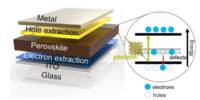Photo batteries, also known as photovoltaic or solar cells, use the photovoltaic phenomenon to convert light energy into electrical energy. In the context of solar cells, achieving competitive voltage usually means boosting voltage output to make the technology more efficient and competitive in the energy market.
The University of Freiburg and Ulm researchers have created a monolithically integrated photo battery out of organic materials.
By monitoring energy consumption in real-time, networked intelligent devices and sensors can increase the energy efficiency of consumer products and buildings. Miniature gadgets like this, which are being developed under the Internet of Things idea, require energy sources that are as small as feasible in order to run autonomously. For this reason, monolithically integrated batteries that create, convert, and store energy in a single system could be used.
The researchers developed a scalable method for the photo battery which allows them to manufacture organic solar cells out of five active layers. The system achieves relatively high voltages of 4.2 volts with this solar cell.
Robin Wessling
A team of scientists at the University of Freiburg’s Cluster of Excellence Living, Adaptive, and Energy-Autonomous Materials Systems (livMatS) has developed a monolithically integrated photo battery consisting of an organic polymer-based battery and a multi-junction organic solar cell.
The battery, presented by Rodrigo Delgado Andrés and Dr. Uli Würfel, University Freiburg, and Robin Wessling and Prof. Dr. Birgit Esser, University of Ulm, is the first monolithically integrated photo battery made of organic materials to achieve a discharge potential of 3.6 volts. It is thus among the first systems of this kind capable of powering miniature devices. The team published their results in the journal Energy & Environmental Science.

Combination of a multi-junction solar cell and a dual-ion battery
The researchers developed a scalable method for the photo battery which allows them to manufacture organic solar cells out of five active layers. “The system achieves relatively high voltages of 4.2 volts with this solar cell,” explains Wessling.
The team paired this multi-junction solar cell with a dual-ion battery, which, unlike typical lithium battery cathodes, can be charged at high currents. A photo battery made in this manner is capable of quick charging in less than 15 minutes at discharge capacities of up to 22 milliampere hours per gram (mAh g-1) with careful control of illumination intensity and discharge rates.
The devices may provide an energy density of 69 milliwatt hours per gram (mWh g-1) and a power density of 95 milliwatts per gram (mW g-1) when combined with an averaged discharge potential of 3.6 volts. “Our system thus lays the foundation for more in-depth research and further developments in the area of organic photo batteries,” Wessling said.
















